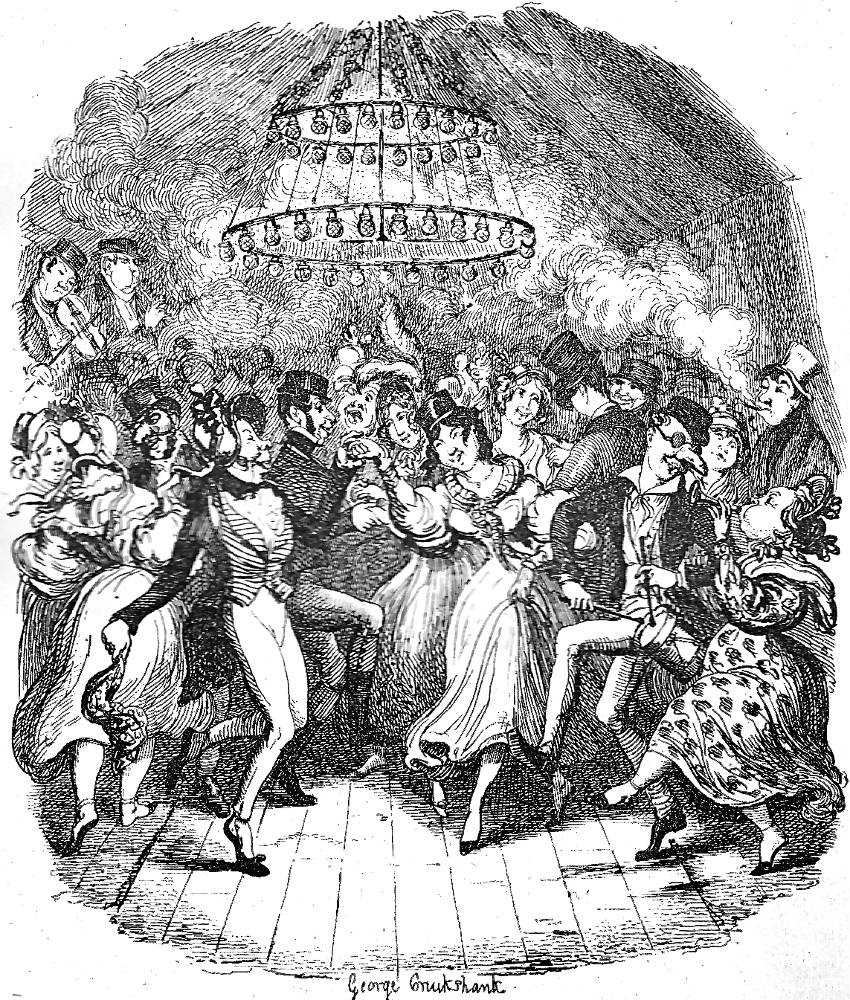Charles Dickens on Dancing at Greenwich Fair

Greenwich Fair. George Cruikshank.
 he grandest and most numerously-frequented booth in the whole fair,
however, is "the Crown and Anchor" — a temporary ball-room — we forget how
many hundred feet long, the price of admission to which is one shilling. Immediately on
your right hand as you enter, after paying your money, is a refreshment place, at which
cold beef, roast and boiled, French rolls, stout, wine, tongue, ham, even fowls, if we
recollect right, are displayed in tempting array. There is a raised orchestra, and the
place is boarded all the way down, in patches, just wide enough for a country dance.
he grandest and most numerously-frequented booth in the whole fair,
however, is "the Crown and Anchor" — a temporary ball-room — we forget how
many hundred feet long, the price of admission to which is one shilling. Immediately on
your right hand as you enter, after paying your money, is a refreshment place, at which
cold beef, roast and boiled, French rolls, stout, wine, tongue, ham, even fowls, if we
recollect right, are displayed in tempting array. There is a raised orchestra, and the
place is boarded all the way down, in patches, just wide enough for a country dance.
There is no master of the ceremonies in this artificial Eden — all is primitive, unreserved, and unstudied. The dust is blinding, the heat insupportable, the company somewhat noisy, and in the highest spirits possible: the ladies, in the height of their innocent animation, dancing in the gentlemen's hats, and the gentlemen promenading "the gay and festive scene" in the ladies' bonnets, or with the more expensive ornaments of false noses, and low-crowned, tinder-box-looking hats: playing children's drums, and accompanied by ladies on the penny trumpet.
The noise of these various instruments, the orchestra, the shouting, the "scratchers,"and the dancing, is perfectly bewildering. The dancing, itself, beggars description—every figure lasts about an hour, and the ladies bounce up and down the middle, with a degree of spirit which is quite indescribable. As to the gentlemen, they stamp their feet against the ground, every time "hands four round"begins, go down the middle and up again, with cigars in their mouths, and silk handkerchiefs in their hands, and whirl their partners round, nothing loth, scrambling and falling, and embracing, and knocking up against the other couples, until they are fairly tired out, and can move no longer. The same scene is repeated again and again (slightly varied by an occasional "row") until a late hour at night: and a great many clerks and'prentices find themselves next morning with aching heads, empty pockets, damaged hats, and a very imperfect recollection of how it was they did not get home. — "Scenes," Chapter 12, "Greenwich Fair," p. 87.
Other Depictions of the Fair

Phiz's rather tamer image of the fair, just four years before the Home Secretary cancelled it, Whitsuntide at Greenwich Park (21 May 1853). The Illustrated London News by Phiz, who replaced Cruikshank as Dickens's chief illustrator, shows innocuous afternoon entertainments, featuring in the lower left a Greenwich Naval Pensioner's offering to conduct a guided tour of lurid local scenes while on the hill (upper right) while another such retiree offers to show "interesting sights" through a telescope. [Click on the image to enlarge it.]

Fred Barnard's realistic wood-engraving of an impromptu picnic on the hill beneath the Greenwich Observatory in The gentleman described looks extremely foolish, and squeezes her hand, and fees the Gipsy liberally (1876). Barnard's response to George Cruikshank's exuberant illustration of the Whitsuntide revelry at Greenwich Park for the Second Series of "Scenes" in Sketches by Boz. Set on the slopes of Observatory Hill, Barnard's realisation of one of the scenes in the 16 April 1835 essay originally entitled "Sketches of London No. 9" is far more sedate and wholesome than the original copper-engraving Greenwich Fair, in which the dancers abandon strict propriety in matters of dress and embrace the spirit of the bachanal at the notorious Crown and Anchor dancing-booth.
Related Material
Bibliography
Dickens, Charles. "Greenwich Fair," Chapter 12 in "Scenes," Sketches by Boz. Illustrated by George Cruikshank. London: Chapman and Hall, 1839; rpt., 1890. Pp. 81-87.
Dickens, Charles. "Greenwich Fair," Chapter 12 in "Scenes," Sketches by Boz. Illustrated by Fred Barnard. The Household Edition. London: Chapman and Hall, 1876. Pp. 115-56.
Dickens, Charles. "Greenwich Fair," Chapter 12 in "Scenes," Sketches by Boz. Illustrated by Harry Furniss. The Charles Dickens Library Edition. London: Educational Book Company, 1910. Vol. 1. Pp. 104-112.
Last modified 11 May 2017